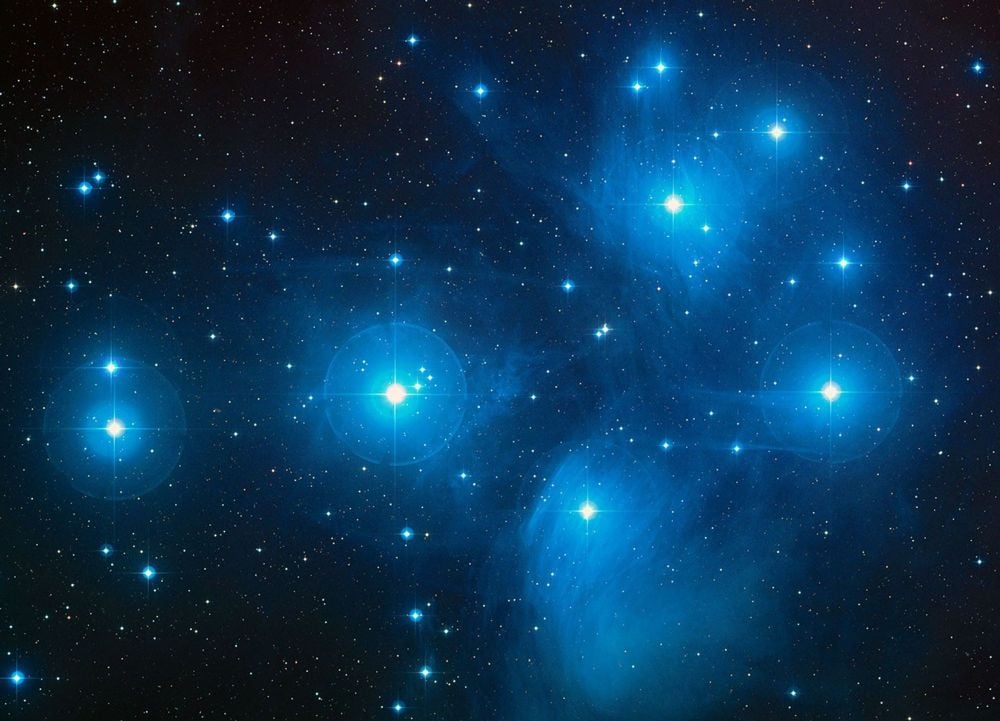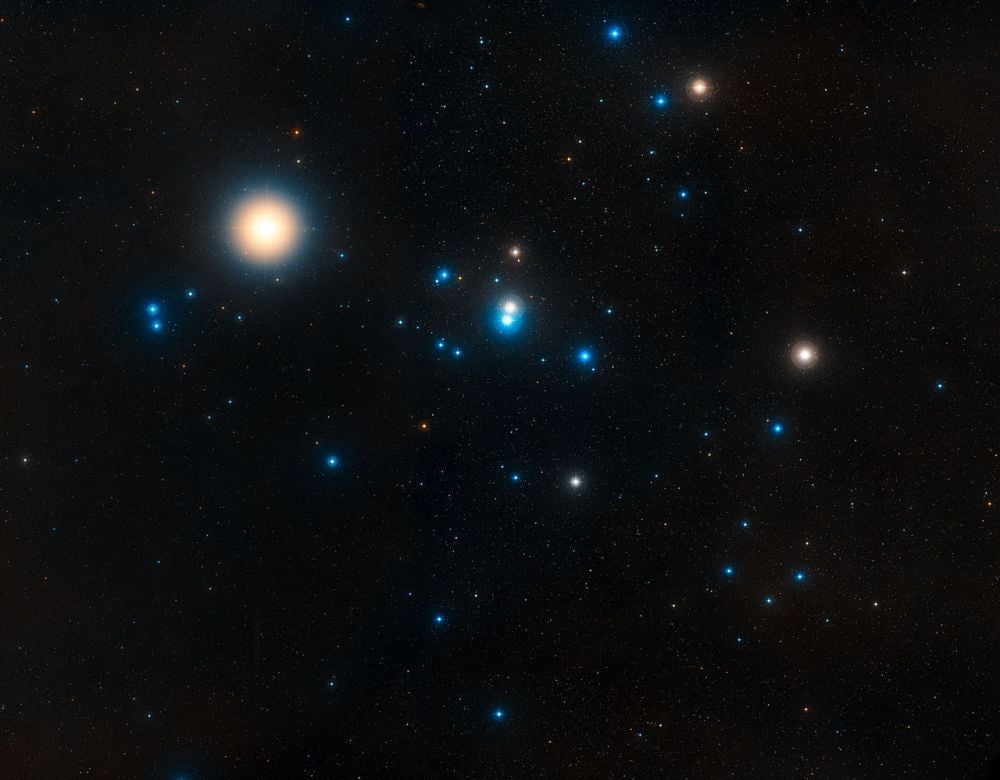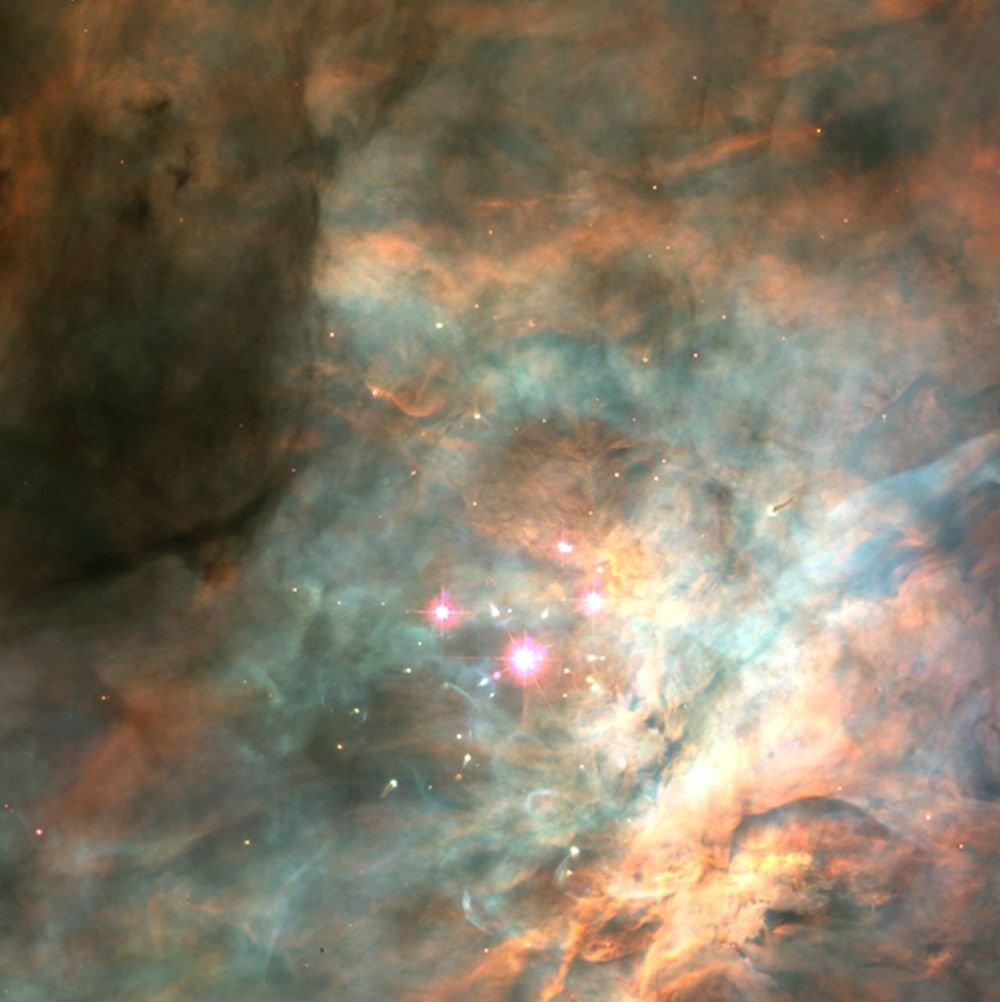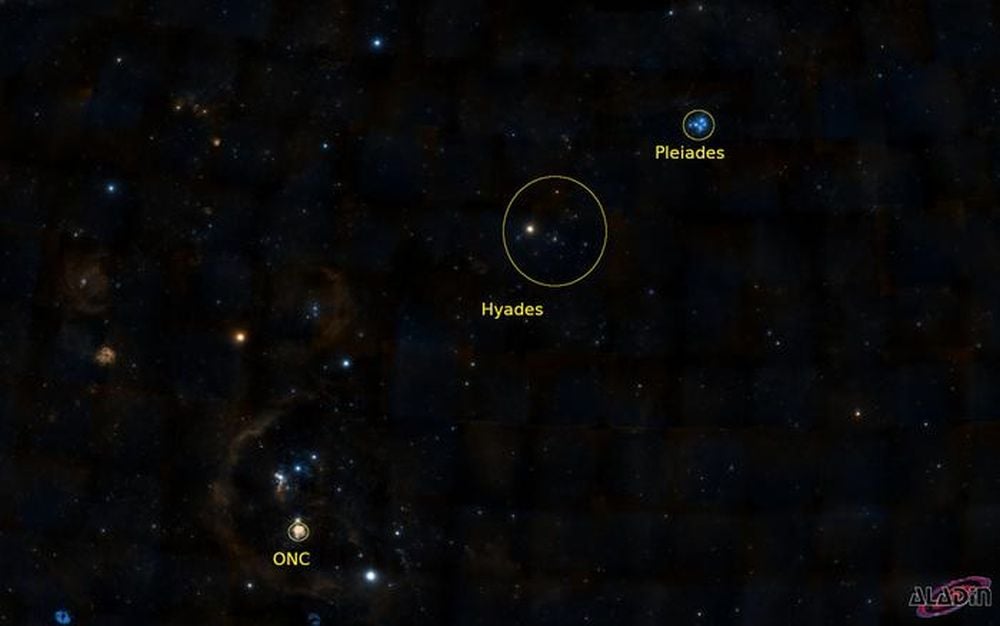The Orion Nebula Cluster, the Pleiades, and the Hyades are all open star clusters located near each other. They’re easily located in the night sky. The Pleiades, aka the Seven Sisters, and the Hyades are close together, and the ONC is a little further away below Orion’s Belt in the Orion Nebula.
Researchers in Iran and Germany have used observations of all three, alongside computer modelling, to uncover a new connection between the three. They say that these three well-known clusters represent three different evolutionary stages of open clusters. Their results are in a paper in the Monthly Notices of the Royal Astronomical Society titled “Are the ONC, Pleiades, and Hyades snapshots of the same embedded cluster?” The lead author is Ghasem Safaei, from the Department of Physics, Institute for Advanced Studies in Basic Sciences, in Iran.
“Most Galactic field stars are not formed in isolation; rather, they originate within star clusters (SCs) embedded in giant molecular clouds that are initially compact structures,” the authors explain in their paper. “The early evolution (first ≈10 Myr) of young, gas-embedded SCs is primarily dominated by the removal of residual gas from star formation, driven by feedback from massive stars through ultraviolet (UV) radiation, stellar winds from OB stars, and supernova explosions.” This loss of mass signals what’s to come for the clusters, as they gradually evaporate over time until the cluster association is lost and their stars become field stars.
The Hyades, Pleiades, and the ONC shown in context. The three are in the same region of the sky, prompting astronomers to wonder if they’re connected somehow. Image Credit: Safaei et al. 2025. MNRAS
The ONC, Pleiades, and Hyades are all open clusters, but they’re different ages with different stellar populations. The ONC is the youngest, only 2.5 million years old, and is an active star formation region. There are different estimates for its number of stars. Some say about 2,800, some say about 4,200 and some say as many as 10,000. The number is difficult to determine because the ONC is young and still contains clouds of gas and dust that birthed the stars, which can obscure its members.
The Pleiades is older at about 100 million years. It contains about 1,059 stars, and is dominated by 14 hot young stars that are seen with the naked eye. Its stars are more loosely scattered than the ONC’s.
 The Pleiades, or Subaru in Japan, is an open cluster about 440 light-years away. It’s the most obvious naked eye open cluster in the night sky. Image Credit: NASA, ESA and AURA/Caltech
The Pleiades, or Subaru in Japan, is an open cluster about 440 light-years away. It’s the most obvious naked eye open cluster in the night sky. Image Credit: NASA, ESA and AURA/Caltech
The Hyades is the oldest of the three. It’s about 700 million years old, has about 400 stars, and is more widely dispersed than the other two. About one-third of its stars are in the cluster’s extended halo, and astronomers think these stars are escaping the cluster. Eventually, all clusters ‘evaporate’ like this and generally only exist for several hundred million years.
 The Hyades cluster is the closest cluster to Earth. It’s about 153 light-years away and contains hundreds of stars in a spherical grouping. Image Credit: NASA, ESA, and STScI.
The Hyades cluster is the closest cluster to Earth. It’s about 153 light-years away and contains hundreds of stars in a spherical grouping. Image Credit: NASA, ESA, and STScI.
The researchers used N-body simulations to study how clusters evolve. They started out with a young cluster that’s an analog of the ONC. They varied the parameters, including the total mass, the half-mass radius, and the core radius to see what combination generated the observed current ONC. “Additionally, we examine the cluster’s evolution over 800 Myr to determine whether it could reproduce the present-day properties of the Pleiades and Hyades along its evolutionary path,” the researchers explain in their paper.
They found that due to rapid gas expulsion driven by the Milky Way’s tidal field, the simulated ONC suffered significant mass loss. About 100 million years into the simulation, the cluster retained only 47% of its initial 4,200 stars. After 700 million years, it retained only 9%.
“These evolutionary stages closely match the properties of the Pleiades and Hyades, suggesting that an ONC-like cluster may have been their precursor,” the authors write in their research.
“Our highly precise stellar dynamics calculations have now shown that all three star clusters originated from the same predecessor,” says Prof. Dr. Pavel Kroupa from the Helmholtz Institute for Radiation and Nuclear Physics at the University of Bonn, a co-author of the publication.
The ONC, the Pleiades, and the Hyades are like snapshots from a family album. The ONC is the toddler, the Pleiades is the adult, and the Hyades is the grandparent.
“From this we can learn that open star clusters seem to have a preferred mode of star formation,” said Kroupa in a press release. “It appears that there is a preferred physical environment in which stars form when they evolve within these clouds,” says the astrophysicist.
The model shows that ONC likely had an initial mass of between 1200 and 2000 solar masses. It also showed that it’s initial population is between 4,000 and 5,000 stars, which lines up with the approximately 4,200 identified by some astronomers. The model also showed that to produce these three differently-aged clusters, they had to be a rich in binary stars. It also showed that mass segregation played an important role, where more massive stars “sink” toward the cluster’s center, while less massive stars gather on the periphery.
 This Hubble Space Telescope image shows the Trapezium Cluster, the most well-known part of the Orion Nebula Cluster. Since the ONC is young, there’s still plenty of gas and dust that obscures its view. Image Credit: C.R. O’Dell and S.K. Wong (Rice University) and NASA/ESA
This Hubble Space Telescope image shows the Trapezium Cluster, the most well-known part of the Orion Nebula Cluster. Since the ONC is young, there’s still plenty of gas and dust that obscures its view. Image Credit: C.R. O’Dell and S.K. Wong (Rice University) and NASA/ESA
Overall, the model’s results agree well with the observed properties of all three clusters. “In this study, we successfully reproduced the dynamical evolution of the ONC, Pleiades, and Hyades, suggesting that the Pleiades may have been similar to the ONC about 100 Myr ago and will be similar to the Hyades around 700 Myr in the future,” the authors write.
Over time, according to the simulations, clusters like the ONC can lose 85% of their stars, yet still retain a coherent structure, as Hyades shows. This is after passing through an intermediate stage that resembles the current Pleiades cluster. “Our simulations reveal substantial mass loss over time, with clusters losing 50–60 per cent of their mass in 110 Myr and 70–85 per cent in 794 Myr, consistent with the observed evolution of the Hyades,” the authors write.
“This research gives us a deeper understanding of how star clusters form and develop and illustrates the delicate balance between internal dynamics and external forces such as the gravitational pull of the Milky Way,” said study co-author Prof. Akram Hasani Zonoozi.
Many discoveries in astronomy concern distant objects, impossible to observe without powerful telescopes and modern equipment. But these three clusters are easily seen and located in the night sky, with the naked eye or maybe with binoculars. Anyone with access to the night sky in the right part of the world can observe these clusters and think about these findings.
Our Sun was once a cluster star, but at almost five billion years old, it long ago left its cluster behind is just another field star, now.
